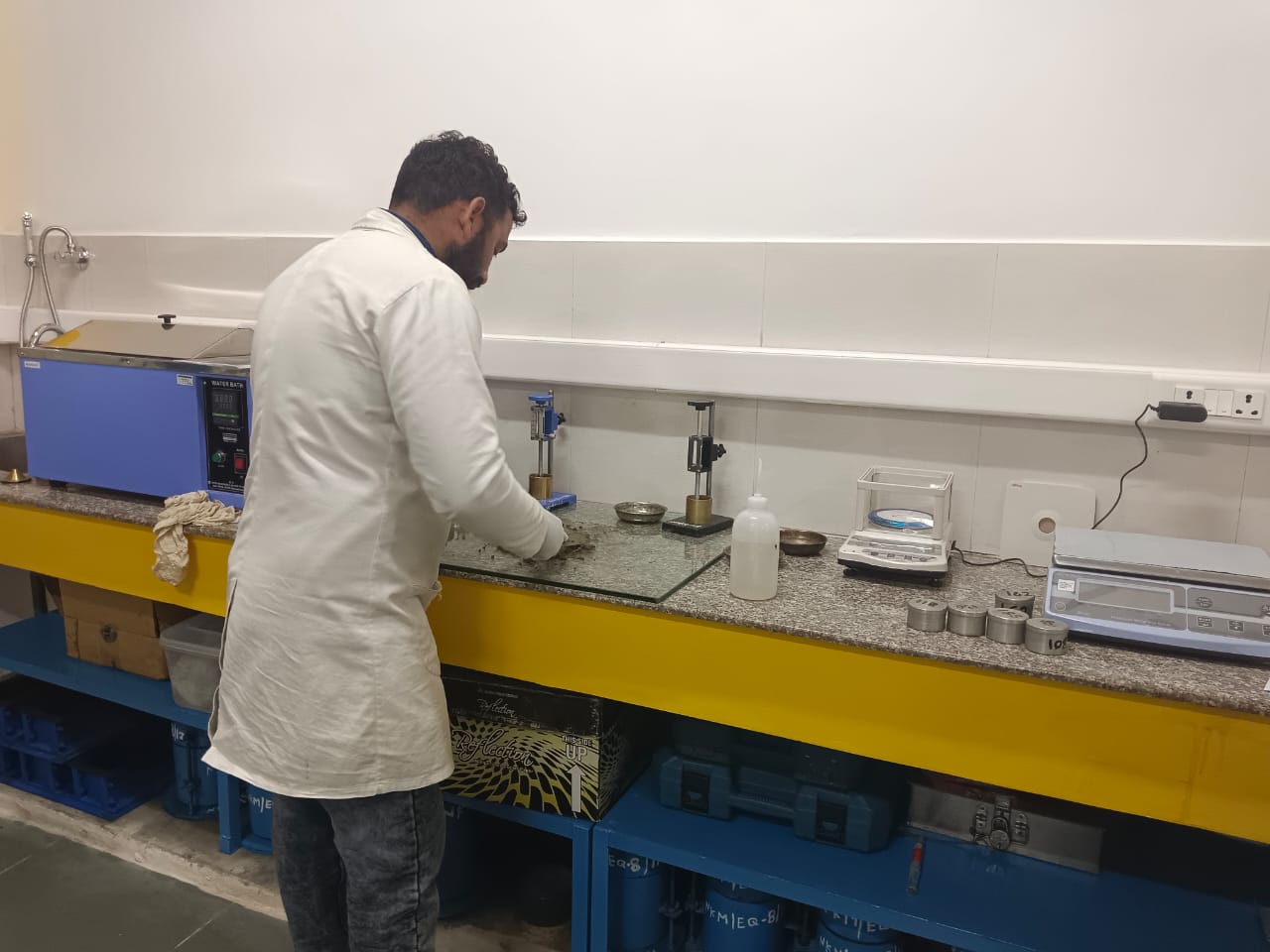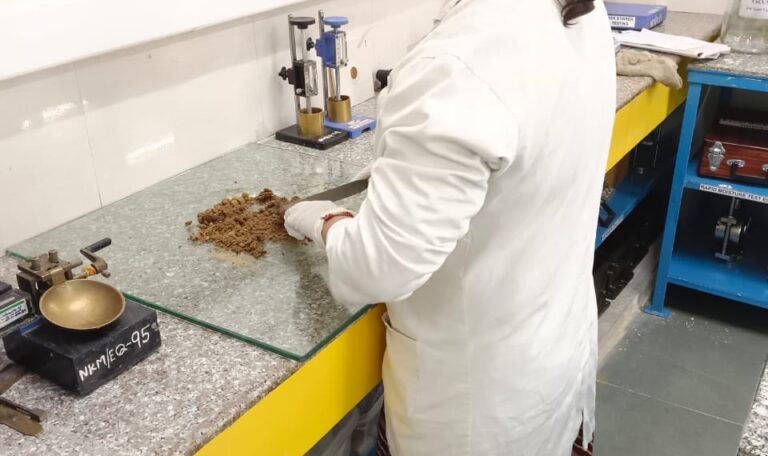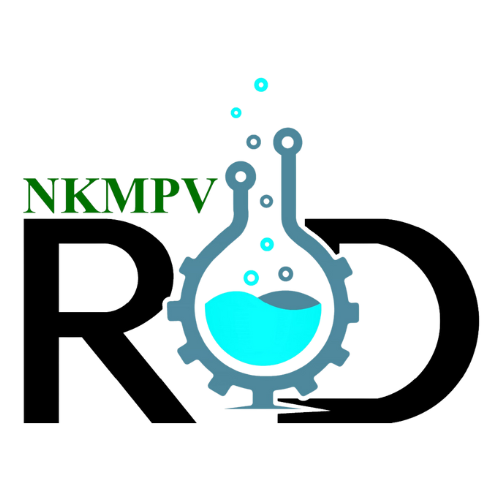Liquid Limit and Plastic Limit Testing

Liquid Limit and Plastic Limit Testing
1. Introduction
The study of soil properties is central to geotechnical engineering and construction. Soil behavior, particularly its response to moisture variations, directly affects the performance of structures such as roads, embankments, and foundations. Two of the most important properties of soil in this context are the Liquid Limit (LL) and Plastic Limit (PL), collectively known as Atterberg Limits. These parameters define the boundaries of soil consistency states and provide critical data for soil classification and behavior analysis.
The Liquid Limit (LL) is the moisture content at which soil transitions from a plastic to a liquid state, while the Plastic Limit (PL) is the moisture content at which soil changes from a semi-solid to a plastic state. The difference between these values, the Plasticity Index (PI), represents the range of water content over which soil exhibits plastic behavior. These tests are standardized in IS: 2720 (Part 5) – 1985 (Reaffirmed 2020) and play a pivotal role in geotechnical investigations.
This report provides an in-depth explanation of LL and PL testing, including their theoretical basis, detailed methodology, significance, and real-world applications.
2. Objectives of the Test
The primary objectives of determining the Liquid Limit and Plastic Limit of soil are as follows:
- Classifying Soil Properties: LL and PL are used in systems like the Unified Soil Classification System (USCS) or the Indian Standard Soil Classification System (ISSCS).
- Assessing Soil Behavior: These limits help predict soil responses to moisture changes, such as swelling, shrinkage, and deformation.
- Foundation Suitability: LL and PL testing identifies whether the soil can safely support structures, particularly in expansive soils.
- Calculating Plasticity Index (PI): The PI is a measure of soil plasticity, helping engineers differentiate between cohesive and non-cohesive soils.
- Optimizing Construction Techniques: These tests guide soil compaction, stabilization, and improvement methods.
3. Theoretical Background
3.1 Atterberg Limits and Soil States
Atterberg Limits define the water content at which soil changes from one state to another:
- Solid State: Soil is rigid, brittle, and breaks under stress.
- Semi-Solid State: Soil deforms but does not return to its original shape.
- Plastic State: Soil is moldable without cracking.
- Liquid State: Soil flows like a viscous liquid under its own weight.
3.2 Liquid Limit (LL)
The Liquid Limit (LL) is the moisture content at which soil transitions from a plastic to a liquid state. At this moisture content, the soil has minimal shear strength and can no longer hold its shape. LL is determined using the Casagrande liquid limit device, where controlled impacts are applied to a soil sample in a metal cup to simulate flow conditions.
Relevance:
- LL helps classify fine-grained soils (e.g., clays and silts).
- It indicates the soil’s water retention and sensitivity to changes in moisture.
3.3 Plastic Limit (PL)
The Plastic Limit (PL) is the moisture content at which soil transitions from a semi-solid to a plastic state. Below the PL, soil crumbles when rolled into thin threads. This property represents the lowest moisture content at which soil exhibits plasticity.
Relevance:
- PL reflects the minimum moisture content required for soil to be workable.
- It provides insight into the soil’s compressibility and strength.
3.4 Plasticity Index (PI)
The Plasticity Index (PI) is defined as:
PI=LL−PLPI = LL – PLPI=LL−PL
- A high PIindicates a highly plastic and cohesive soil, such as clay.
- A low PIindicates non-cohesive soils like silts or sands.
The PI provides critical information for assessing soil expansion potential, workability, and stability under varying moisture conditions.
4. Apparatus Required
The following equipment is essential for conducting LL and PL tests as per IS: 2720 (Part 5):
- Casagrande Liquid Limit Device: Measures LL by simulating soil flow under mechanical impacts.
- Grooving Tools: Creates grooves in soil for LL testing.
- Glass Plate: Provides a smooth surface for rolling soil threads during PL testing.
- IS Sieve (425 Microns): Ensures soil particle uniformity for accurate results.
- 3 mm Diameter Rod: Verifies thread diameter during PL testing.
- Spatula: For mixing and transferring soil.
- Balance (0.01 g Sensitivity): Precisely measures soil and water content.
- Drying Oven: Maintains consistent temperature for moisture determination.
- Distilled Water: Prevents contamination or ion exchange.
- Desiccator: Prevents moisture loss before weighing.
- Graph Paper: For plotting LL flow curves.
5. Testing Procedures
5.1 Liquid Limit (LL) Test
Step-by-Step Methodology:
- Device Calibration:
- Adjust the Casagrande device using a grooving tool gauge to ensure the cup drops exactly 1 cm.
- Soil Preparation:
- Take 120 g of air-dried soil, sieve it through a 425-micron sieve, and mix with distilled water to form a uniform paste.
- Groove Formation:
- Place the soil paste in the Casagrande cup and smooth it to 1 cm depth.
- Cut a groove along the center using the grooving tool.
- Blow Counting:
- Turn the handle at 2 revolutions per second and record the number of blows required for the groove to close along a 10 mm length.
- Moisture Content Determination:
- Transfer a portion of soil from the closed groove into a container and determine its moisture content using an oven.
- Repeat Testing:
- Perform the test with varying moisture contents to obtain at least four sets of readings.
- Flow Curve Plotting:
- Plot moisture content against the logarithm of blows. The LL corresponds to the moisture content at 25 blows.
5.2 Plastic Limit (PL) Test
Step-by-Step Methodology:
- Sample Preparation:
- Pass 30 g of soil through a 425-micron sieve.
- Mix it with distilled water until it forms a moldable ball.
- Thread Rolling:
- Roll the soil into threads on a glass plate using palms, ensuring uniform diameter reduction.
- Thread Crumbling:
- Stop rolling when the threads begin to crumble at a diameter of 3 mm.
- Moisture Content Determination:
- Collect the crumbled threads and determine their moisture content using an oven.
- Repeat Testing:
- Conduct the test on at least three fresh soil samples to ensure accuracy.
5.3 Precautions
- Use distilled water to avoid impurities.
- Prevent excessive drying of soil samples before testing.
- Ensure even and thorough mixing of soil and water.
- Clean all tools after each test to avoid contamination.
- Perform the test at standard room temperature for consistency.

6. Benefits of LL and PL Testing
Here are the primary benefits:
6.1. Soil Classification and Identification
- Liquid limit and plastic limitvalues are used to classify soils into groups such as clays, silts, or a combination. This classification is critical for predicting soil behavior in engineering applications.
- The plasticity index (PI), derived from LL and PL (PI=LL−PLPI = LL – PLPI=LL−PL), indicates the plasticity and cohesion characteristics of the soil.
6.2. Assessment of Engineering Properties
- Strength and Stability:Soils with high plasticity (high PI) may exhibit significant shrink-swell behavior, which can affect foundation stability.
- Compressibility:LL and PI are indicators of a soil’s compressibility, helping engineers predict settlement potential.
- Shear Strength:These limits provide insights into the soil’s shear strength in wet conditions.
6.3. Design of Earthworks and Foundations
- Helps determine the suitability of soil as a construction material for roads, dams, embankments, and foundations.
- Assists in designing appropriate soil stabilization methods if the soil exhibits undesirable properties (e.g., high shrink-swell potential).
6.4. Moisture Sensitivity
- LL and PL values help assess how sensitive the soil is to changes in moisture content, which is vital for projects exposed to varying weather conditions.
6.5. Behavior Under Loading
- These tests aid in understanding how soil will behave under different loading conditions, ensuring proper safety and durability in construction.
6.6. Prediction of Shrink-Swell Behavior
- High plasticity soils (high PI) tend to exhibit shrinkage or swelling when moisture content changes. Knowing this helps engineers mitigate risks in construction projects.
6.7. Erosion and Permeability
- The LL and PL can indicate the potential for soil erosion and its permeability, influencing drainage and erosion control strategies.
6.8. Quality Control
- These tests ensure consistency and reliability of soil properties during construction projects, reducing risks of failure.
7. Advantages of Testing
- Early Problem Detection:
- Identifies problematic soils, reducing risks of settlement, cracking, or instability.
- Cost Optimization:
- Provides accurate soil classification, preventing overdesign.
- Environmental Sustainability:
- Helps select materials and methods that minimize environmental impact.
8. Applications
- Road Subgrade Design:
- Ensures the stability of roads under traffic loads.
- Dam Construction:
- Assesses soil impermeability for water retention.
- Slope Stability:
- Predicts landslide risks in hilly terrains.
- Pavements:
- Guides material selection for long-lasting surfaces.
Code Reference:
- ASTM Standards
- ASTM D4318: Standard Test Methods for Liquid Limit, Plastic Limit, and Plasticity Index of Soils.
- Widely used in the United States and internationally.
- Covers both the Casagrande cup method and the fall cone method for determining liquid limits.
- AASHTO Standards
- AASHTO T89: Standard Method of Test for Determining the Liquid Limit of Soils.
- AASHTO T90: Standard Method of Test for Determining the Plastic Limit and Plasticity Index of Soils.
- Commonly used for transportation and highway projects in the U.S.
- British Standards (BS)
- BS 1377-2: Methods of Test for Soils for Civil Engineering Purposes – Part 2: Classification Tests.
- Includes the liquid limit, plastic limit, and plasticity index tests.
- Often used in Europe and Commonwealth countries.
- Indian Standards (IS)
- IS 2720 (Part 5): 1985: Determination of Liquid and Plastic Limits.
- Used extensively in India for soil classification and geotechnical analysis.
- International Organization for Standardization (ISO)
- ISO 17892-12:2018: Geotechnical investigation and testing – Laboratory testing of soil – Part 12: Determination of liquid and plastic limits.
- Provides a global reference for soil testing.
Key Points to Note:
- These codes outline step-by-step procedures, equipment requirements, and calculation methods.
- They provide tolerance limits and specify reporting formats to ensure consistency and accuracy.
- The choice of standard depends on regional practices, project specifications, and contractual requirements.
Conclusion
The determination of Liquid Limit (LL) and Plastic Limit (PL) is a fundamental aspect of soil mechanics and geotechnical engineering. These tests not only provide a scientific basis for classifying soils but also offer critical insights into their behavior under varying moisture conditions. By understanding these properties, engineers can accurately predict how soils will perform in real-world construction scenarios, reducing the risk of structural failures and ensuring long-term stability.
The Liquid Limit (LL) test measures the moisture content at which soil transitions from a plastic to a liquid state, helping identify the soil’s water retention capacity and sensitivity. The Plastic Limit (PL) test, on the other hand, determines the lowest moisture content at which soil behaves plastically, offering insights into its workability and cohesion. Together, these parameters define the Plasticity Index (PI), a key indicator of soil plasticity and compressibility.
These tests have far-reaching applications in civil engineering, from designing stable foundations and embankments to constructing roads and retaining structures. The data derived from LL and PL testing enable engineers to:
- Select appropriate soil types for construction.
- Design mitigation strategies for expansive or weak soils.
- Optimize soil stabilization and compaction techniques.
- Develop sustainable and cost-effective infrastructure solutions.
Broader Implications
The LL and PL tests are vital in regions prone to extreme weather, where soil moisture conditions fluctuate significantly. For instance:
- In arid regions, the low water retention of soils can lead to challenges in maintaining structural stability, which these tests help address.
- In wet regions, LL and PL data help in mitigating risks of excessive swelling or liquefaction.
In the context of climate change, where rising temperatures and erratic rainfall patterns are altering soil properties globally, the importance of accurately determining LL and PL has become even more pronounced. These tests contribute to resilient infrastructure capable of withstanding environmental stresses.
Improved Decision-Making
By following standardized procedures such as IS: 2720 (Part 5), the results of LL and PL tests are both reliable and reproducible, forming a basis for sound engineering decisions. These tests empower project teams to:
- Anticipate challenges in soil behavior.
- Reduce maintenance costs by building stable structures.
- Improve project efficiency through accurate soil classification and analysis.
Future Directions
Advancements in technology offer promising opportunities to enhance LL and PL testing:
- Automation: Automated liquid limit devices and precision instruments can reduce human errors and improve accuracy.
- Digital Analysis: Incorporating AI and machine learning can allow faster interpretation of soil data, improving decision-making in large-scale projects.
- Field Adaptations: Portable LL and PL testing equipment can provide real-time insights during field investigations.
Final Thoughts
In conclusion, the LL and PL tests remain cornerstones of geotechnical investigations, offering valuable data for designing safe, durable, and sustainable infrastructure. The ability to classify soils, predict their behavior, and design around their limitations ensures that engineers can address challenges posed by natural soils effectively. As engineering demands evolve and environmental factors become increasingly unpredictable, the importance of such standardized tests will only grow. By embracing advancements in testing methods and continuing to refine their application, the field of geotechnical engineering can rise to meet the demands of modern construction and environmental sustainability.
